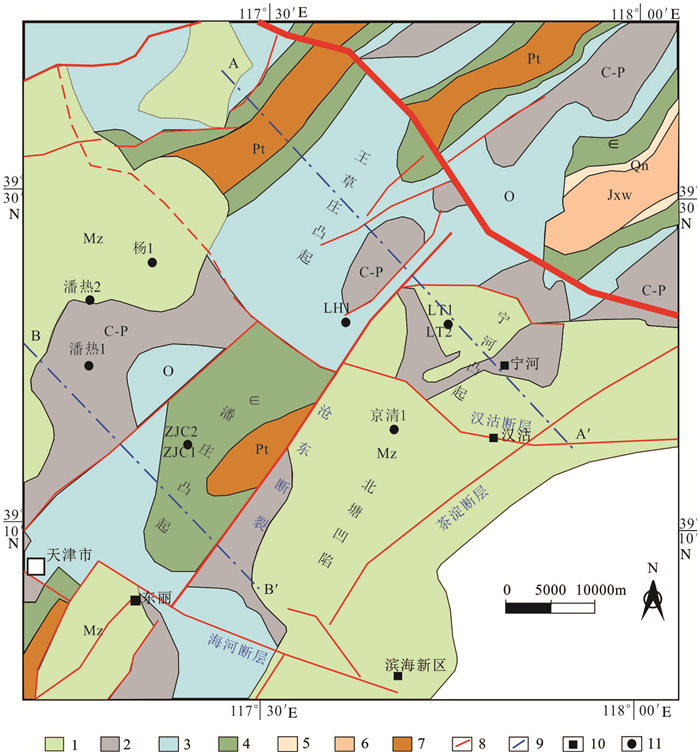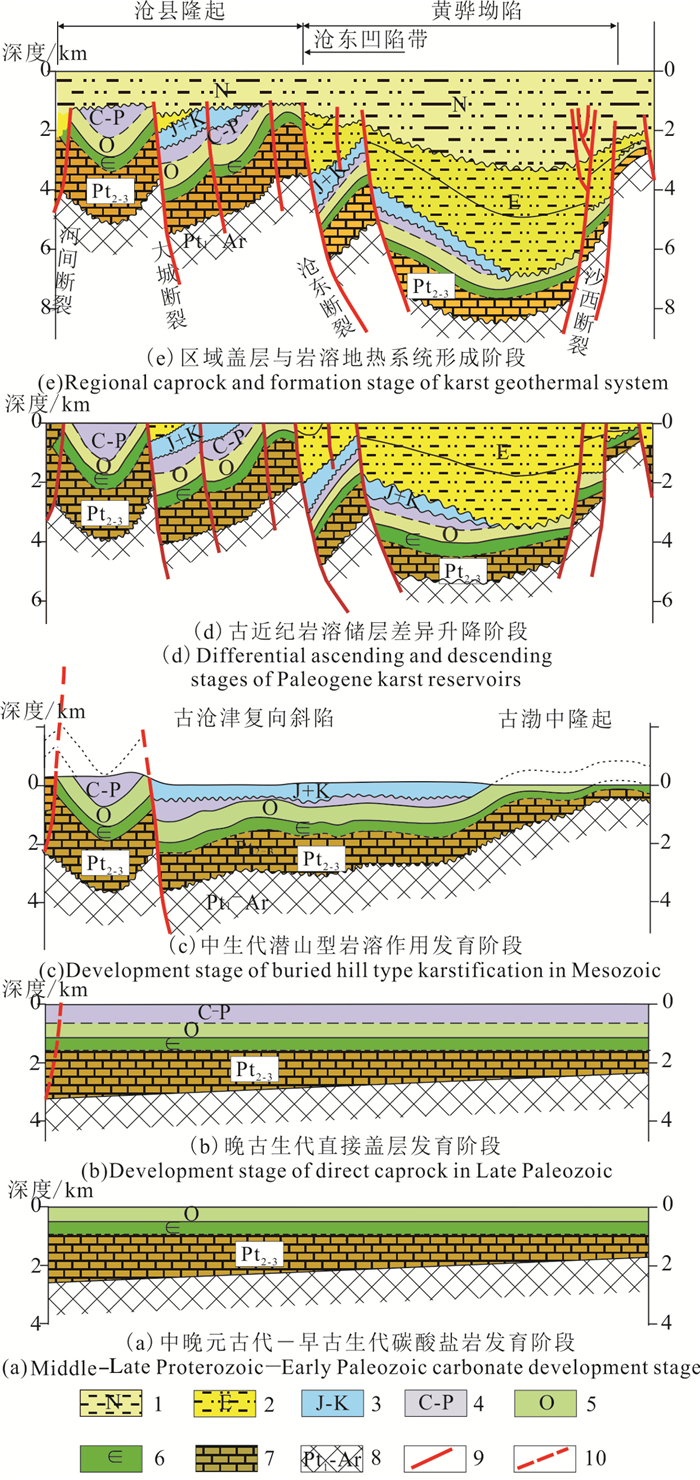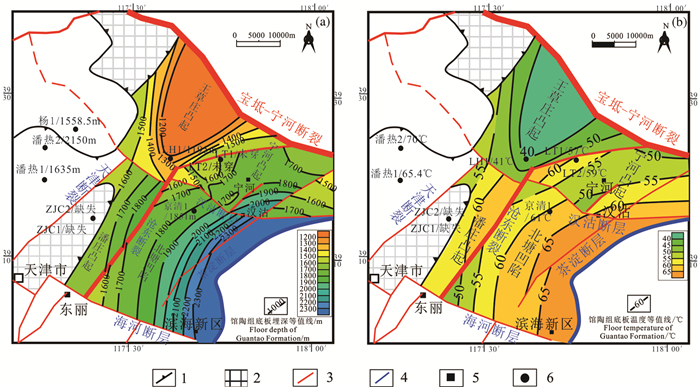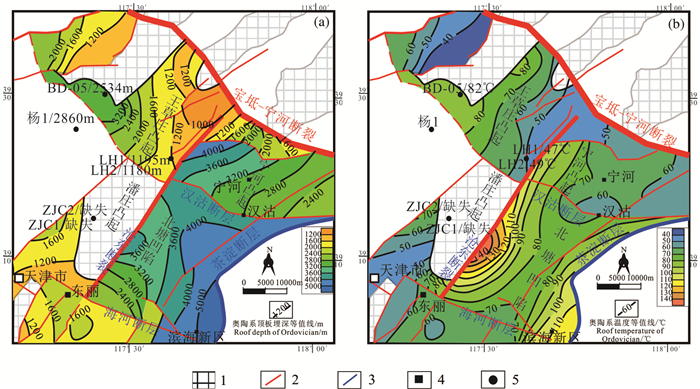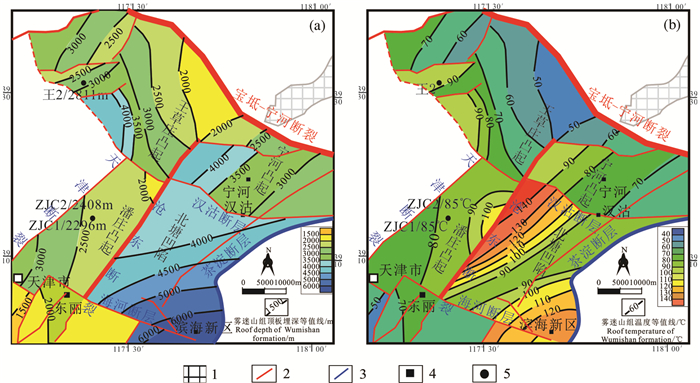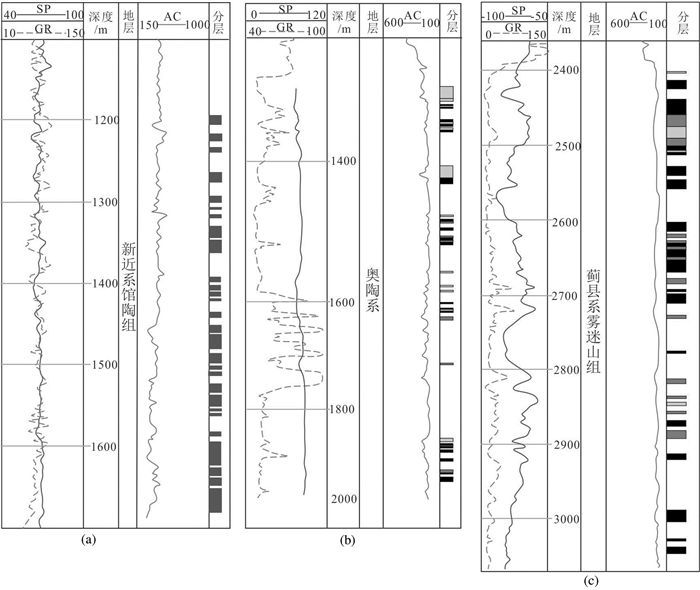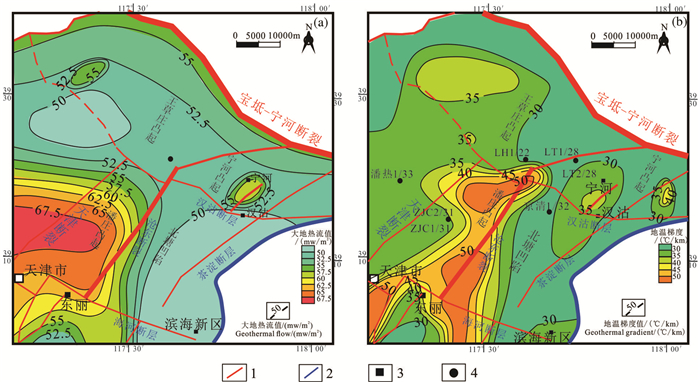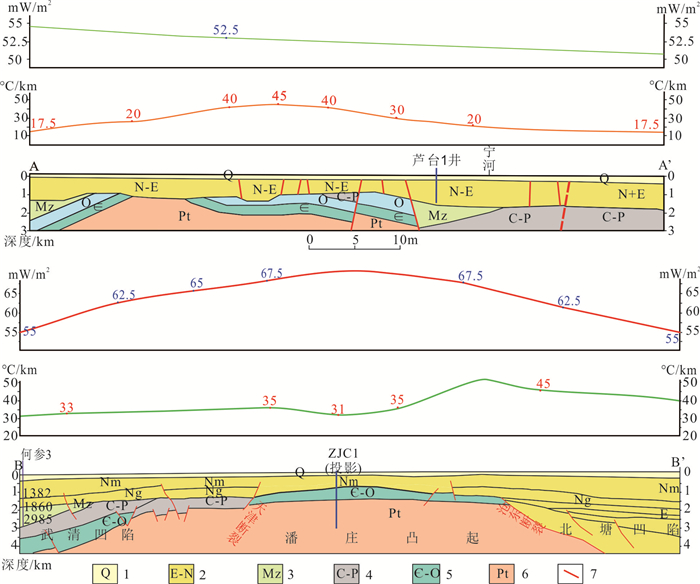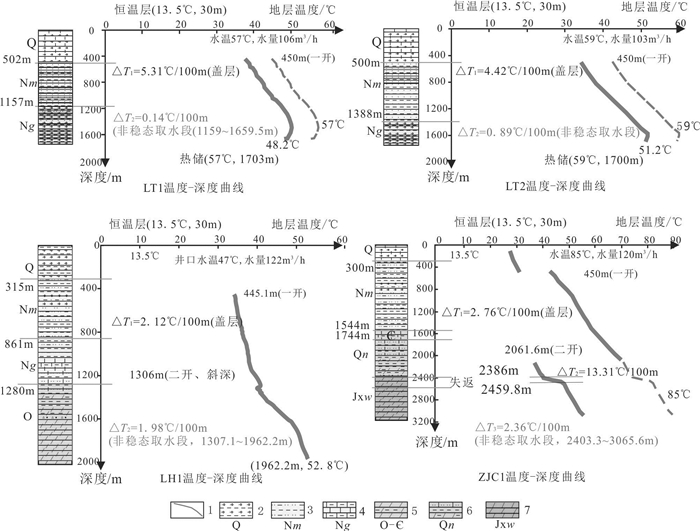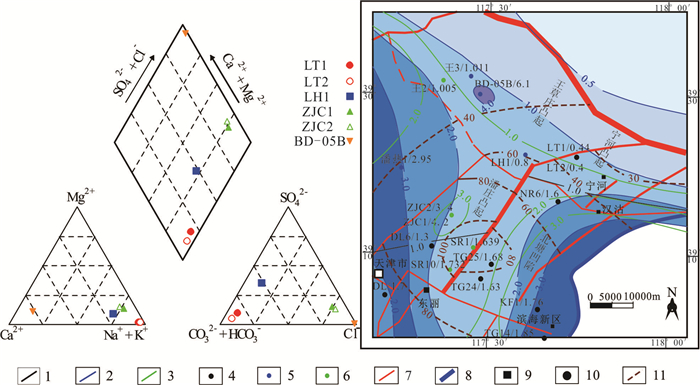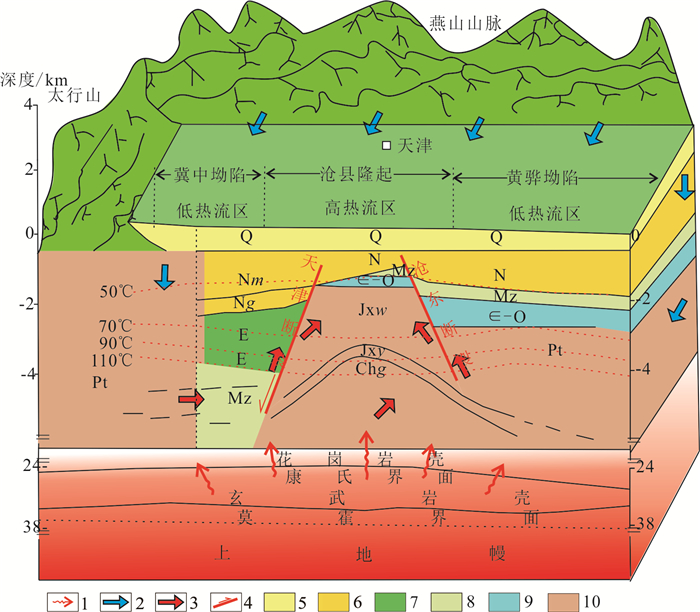Characteristics and development potential of geothermal resources in northern Cangxian uplift
-
摘要:研究目的
地热资源特征研究及开发潜力分析是开发区域地热资源的重要依据。
研究方法本文将前人研究成果与最新钻井资料相结合,通过对沧县隆起北部地区地热地质背景、热储分布、地温场特征、水化学资源类型等主要因素进行剖析,建立了该区的地热成藏模式。
研究结果沧县隆起北部地区是在渤海湾伸展型沉积盆地高大地热流值背景下,由北部燕山裸露区基岩接受的大气降水作为近源补给水源,进入基岩的冷水在深层循环过程中受到深部热源加热增温,沿断裂破碎带和不整合面向上运移富集,形成的以传导型传热机制为主的地热系统。
结论本区地热资源特点为热储类型多、盖层地温梯度高、补给速度快、资源量巨大。主要表现为:区内分布馆陶组砂岩热储,奥陶系、蓟县系雾迷山组岩溶热储三套主力热水储集层;地温场分布主要受基底构造形态控制,基岩凸起区的平均地温梯度为45℃/km;地下水类型随着埋深的增加由HCO3-Na、HCO3·SO4-Na型水向成熟的Cl-Na型水过渡;本区内三套热储的可采地热资源量为1.67×1010GJ,折合标煤5.72×108t,年可开采地热资源量可满足供暖面积2亿m2,若在采灌平衡的条件下,沧县隆起北部地区年可采地热资源量为7.06×107GJ,折合标煤2.41×106t,可满足供暖面积0.85亿m2,具有良好的地热市场开发前景。
创新点:通过地质构造背景、热储分层段特征、地温场平面与垂向分布、水化学运移路径多角度刻画沧县隆起北部地区地热资源特征并建立地热概念模型,在此基础上计算本区年可采地热资源量,对分析采灌平衡的条件下的地热开发潜力具有创新意义。
Abstract:This paper is the result of geothermal geological survey engineering.
ObjectiveThe characteristics and development potential of geothermal resources is an important basis for the development of regional geothermal resources.
MethodsCombined the previous research results with the latest drilling data, the geothermal reservoir model is established based on the analysis of the main factors such as geothermal geological background, thermal reservoir distribution, geothermal field characteristics and hydrochemical resource types in the northern Cangxian uplift.
ResultsUnder the background of high heat flow value in the extensional sedimentary basin of Bohai Bay, the atmospheric precipitation received by the bedrock in the exposed area of Yanshan Mountain in the north is used as the near source water supply. The cold water enters the bedrock, is heated by the deep heat source in the deep circulation process, and migrates and enriches along the fracture zone and unconformity surface, and forms the geothermal heat transfer mechanism dominated by conduction system.
ConclusionsThe geothermal resources in this area are characterized by many types thermal reservoirs, high geothermal gradient of caprock, rapid recharge rate and huge resources. It is mainly shown as follows: Three sets of main hot water reservoir, sandstone thermal reservoir of Guantao Formation, karst thermal reservoir of Ordovician and Jixian Wumishan Formation are distributed in the area; the distribution of geothermal field is mainly controlled by basement structure, and the average geothermal gradient in bedrock uplift area is 45 ℃/km; with the increase of groundwater depth, the groundwater type changes from HCO3-Na, HCO3·SO4-Na to mature Cl-Na; the recoverable geothermal resources in this area is 1.67×1010 GJ, equivalent to 5.72×108t of standard coal. The annual exploitable geothermal resources can meet the heating area of 2×108 m2, considering the balance of exploiting and irrigation, the annual exploitable resource of geothermal fluid in the northern part of Cangxian uplift is 7.06×107 GJ, equivalent to 2.41×106t of standard coal, which can meet the heating area of 8.5×107 m2, which has a good prospect of geothermal market development.
-
1. 前言
太行山存在重力梯度带是华北克拉通最显著的地质特征之一,该梯度带两侧的地貌、大地热流值、地壳厚度和岩石圈厚度存在明显的差异,造成这种差异的原因是华北岩石圈减薄存在时空不均一性[1]。沿该重力梯度带北东向发育大量的晚中生代侵入-火山岩带,特别是在太行山北段。前人对这些侵入岩开展了大量的年代学和地球化学研究[2-3],取得了重要进展。同时在太行山中北段探明存在多个中小型矽卡岩铜多金属矿[4-5]和石湖大型金矿床[6]。近几年在该地区新探明了木吉村大型斑岩型铜(钼)矿[7]和安妥岭大型斑岩型钼矿[8],暗示太行山北段具有很大的找矿潜力。区域地质工作显示,赤瓦屋岩体是太行山北段南部典型的杂岩体[9],前人虽然对该岩体开展过一些锆石测年工作,但多限于岩体边缘相石英闪长岩的研究[10-13],最近的找矿工作新类型铜钨矿体主要集中于岩体中心相斑状花岗闪长岩。因此,本文对赤瓦屋岩体不同岩相开展详细的锆石U-Pb 测年工作,结合区域含矿岩体的年代学资料,以期对太行山北段中生代金属矿床的成矿规律有更明确的认识。
2. 区域地质
研究表明,太行山北段的构造演化大致经历了3 个主要阶段,分别为太古宙变质基底形成阶段、元古宙至古生代稳定发展阶段和中生代活化阶段[14]。阜平杂岩是华北克拉通太古宙变质结晶基底的一部分,现今表现为NE向展布的穹隆状构造,主要岩性为黑云斜长片麻岩、角闪斜长片麻岩、浅粒岩夹斜长角闪岩,该套岩石地层单元普遍遭受强烈区域变质及混合岩化作用[15]。除了阜平杂岩以外,还发育一系列元古宙—侏罗纪沉积地层。岩浆岩是太行山北段中生代活化阶段的产物,沿太行山重力梯度带呈NNE向展布(图 1-a),其分布受东、西两侧分布的NNE 向紫荆关断裂和乌龙沟断裂带控制[5],由NNE向分布的多个岩基(体)和髫髻山组火山岩组成,由北向南依次发育大河南、王安镇岩基和麻棚、赤瓦屋岩体(图 1-b),这些岩体为中酸性高钾钙碱性花岗质岩石[2]。其中王安镇岩基周缘探明了多个斑岩-矽卡岩型多金属矿床,新发现的木吉村大型斑岩铜钼矿和安妥岭大型斑岩型钼矿分别位于该岩基的南缘和北缘;在麻棚岩体西侧1~4 km探明了太行山地区最大的金矿——石湖金矿(图 1-b)。
赤瓦屋岩体位于太行山北段北东向岩浆带的南端,该岩体平面上呈近圆状,直径约5 km,面积约63 km2。根据前人资料和本次野外地质考察,该岩体由不同岩相组成(图 2),自岩体中部向外呈同心圆状展布: 中心相为斑状花岗闪长岩,中粗粒斑状结构,向外过渡为细中粒花岗闪长岩; 边缘相为细粒石英闪长岩(图 3)。不同岩相的黑云母和角闪石含量不同[9],边缘相的黑云母和角闪石含量分别为15%和10%,过渡相分别为10%和5%~10%,中心相角闪石少见,黑云母含量为5%,由边部向内部暗色矿物逐渐减少,暗示岩浆9 演化程度越来越高。除此以外,还发育大量的南北向花岗闪长斑岩脉。
此次野外观察可见,大小为2~10 m的黑色闪长质包体呈椭圆体和透镜状普遍发育于花岗闪长岩中,与寄主岩体边缘清楚。前人对太行山北段岩体开展过成矿潜力评价,赤瓦屋岩体的岩浆分异指数(DI)为75.04,轻重稀土元素比值(LREE/HREE)均较高,为20.2,黑云母MgO为12.80%~14.28%,石英Ti 含量为17×10-6,全岩的氧同位素为8.89%,暗示赤瓦屋岩体具有较大的成矿潜力[9]。早期资料显示该岩体有铜矿化,最近地勘队发现中心相斑状花岗闪长岩中发育铜钨多金属矿化,可见早阶段NE 向石英黄铁矿白钨矿脉和晚阶段SN 向黄铜矿脉,辉钼矿呈细脉浸染状产于岩体中,多与黄铜矿、黄铁矿共生。
3. 样品采集与测试方法
本次测年工作采集4 个不同岩性的样品,分别为石英闪长岩(CWW14)、花岗闪长岩(CWW2)、斑状花岗闪长岩(CWW12) 和花岗闪长斑岩脉(CWW1),具体采样位置见图 2。将测年样品破碎后,经常规重力和磁选方法分选出锆石,在双目镜下挑纯。将待测锆石颗粒置于环氧树脂中制靶,然后磨至一半用于后期测试。锆石阴极发光在中国地质科学院地质研究所离子探针室HITACHIS3000-N型扫描电子显微镜上完成。在透射光、反射光显微镜观察及阴极发光研究的基础上,选择合适的锆石颗粒进行锆石U-Pb定年测试。
LA-MC-ICPMS 锆石U-Pb 定年测试分析在中国地质科学院矿产资源研究所MC-ICP-MS实验室完成,定年分析所用仪器为Finnigan Neptune型MC-ICPMS及与之配套的Newwave UP 213 激光剥蚀系统。所用激光剥蚀斑束直径为25 μm,频率为10 Hz,能量密度约为2.5 J/cm2,以He 为载气。信号较小的207Pb、206P、204Pb(+204Hg)、202Hg 用离子计数器(multi-ion-counters)接收,208Pb、232Th、238U信号用法拉第杯接收,实现了所有目标同位素信号的同时接收,并且不同质量数的峰基本上都是平坦的,可以获得高精度的数据。均匀锆石颗粒207Pb/206Pb、206Pb/238U、207Pb/235U的测试精度(2σ )均为2%左右,对锆石标准样品的定年精度和准确度在1%(2σ )左右。LA-MC-ICPMS 激光剥蚀采样采用单点剥蚀的方式,数据分析前用锆石GJ-1 调试仪器,使之达到最优状态,锆石U-Pb 定年以锆石GJ-1 为外标,U、Th含量以锆石M257(U: 923×10-6; Th: 439×10-6; Th/U:0.475)[16]为外标进行校正。测试过程中每测定5~7个样品前后重复测定2 个锆石标准样品,对样品进行校正,并测量一个锆石标准Plesovice,观察仪器的状态以保证测试精确度。数据处理采用ICPMSDataCal 程序,测量过程中绝大多数分析点206Pb/204Pb>1000,未进行普通铅校正,204Pb 由离子计数器检测,204Pb 含量异常高的分析点可能受包体等普通Pb 的影响,在计算时予以剔除,锆石年龄谐和图用Isoplot 3.0 程序获得。样品分析过程中,Plesovice 标样作为未知样品的分析结果为(337.3±1.1)Ma(n=5,2σ),对应的年龄推荐值为(337.13±0.37)Ma(2σ)[17],两者在误差范围内完全一致,测试数据精度较好。
4. 分析结果
赤瓦屋不同岩相花岗质岩石的锆石U-Pb 分析测试结果见表 1,锆石U-Pb 谐和图见图 4。由图 4可知,石英闪长岩样品CWW14 锆石多呈长柱状,长为80~250 μm,宽为40~120 μm。本文对石英闪长岩中15 颗锆石进行年代学测试,Th 和U含量分别为100×10-6~306×10-6和150×10-6~347×10-6,其Th/U为0.4~1.5(表 1),谐和年龄为(134±1)Ma,MSWD=3.4; 加权平均年龄为(134±2)Ma,MSWD=0.62(图 4-a)。
表 1 太行山北段赤瓦屋铜钨矿区不同岩相的花岗质岩石的锆石U-Pb年龄测年结果Table 1. LA-ICPMS zircon U-Pb data of different petrofacies of granitoids in Chiwawu area,Northern Taihang Mountain
花岗闪长岩样品CWW2 锆石多呈长柱状,锆石长20~320 μm,宽40~120 μm。本文分析了花岗闪长岩中23 颗锆石,Th 和U 含量分别为59.2×10-6~197×10-6 和105×10-6~289×10-6,其Th/U 为0.4~1.0(表 1),谐和年龄为(133±1)Ma,MSWD=2.3; 加权平均年龄为(133±2)Ma,MSWD=0.37(图 4-b)。
斑状花岗闪长岩样品CWW12锆石多呈长柱状,锆石长120~500 μm,宽80~100 μm。本文分析了斑状花岗长岩中12 粒锆石,Th 和U含量分别为88.6×10-6~492×10-6和227×10-6~596×10-6,其Th/U为0.3~0.8(表 1),谐和年龄为(131±2)Ma,MSWD=2.6; 加权平均年龄为(132±4)Ma,MSWD=0.68(图 4-c)。
花岗闪长斑岩脉样品CWW1锆石多呈长柱状,锆石长200~360 μm,宽10~100 μm。本文分析了斑状花岗长岩中28 粒锆石,Th和U含量分别为45.6×10-6~1303×10-6和83.1×10-6~775×10-6,其Th/U比值为0.4~1.7(表 1),谐和年龄为(128 ±1)Ma,MSWD=6.2; 加权平均年龄为(128±1)Ma,MSWD=2.4(图 4-d)。
5. 讨论
5.1 赤瓦屋岩体时代
赤瓦屋岩体位于太行山北段中生代岩浆带的南部(图 1-b),其形成时代受到高度关注。喻学惠等[5]提出该岩体由同心环状的不同岩相带(石英闪长岩、花岗闪长岩和斑状花岗闪长岩)组成,全岩Rb-Sr 等时线年龄为135.2 Ma;刘阳等[10] 利用SHRIMP测年获得该岩体北部和西部边缘相石英闪长岩的锆石U-Pb 年龄分别为(134.0±5.3)Ma 和(139.8±3.1)Ma;李林林等[12]获得该岩体西部边缘相石英闪长岩的LA-ICPMS 锆石U-Pb 年龄为(126.4±2.4) Ma。该岩体北部边缘相花岗闪长岩和闪长岩包体的LA-ICPMS 锆石U-Pb 年龄分别为(130±1.0) Ma和(128.2±1.5) Ma[13]。
如前文所述,赤瓦屋岩体除边缘相石英闪长岩外,还存在过渡相花岗闪长岩、中心相斑状花岗闪长岩和后期酸性岩脉,已有的锆石U-Pb 测年工作主要集中于边缘相[10, 12-13]。本文获得赤瓦屋岩体边缘相石英闪长岩、边缘相花岗闪长岩、中心相斑状花岗闪长岩和后期花岗闪长岩岩脉的锆石LAICPMS谐和年龄分别为(134 ±1)Ma、(133±1)Ma、(131±2)Ma和(128±1)Ma,其中本次边缘相的锆石U-Pb 年龄与前人获得的锆石U-Pb 年龄在误差范围内基本一致,表明本次测年数据是可靠的。本文测年数据表明,赤瓦屋岩体不同岩相体形成时代(134~131 Ma)在识差范围内基本一致,暗示岩浆经历了快速侵位、快速冷却结晶的地质过程,类似于邻区的麻棚岩体[12]。据野外实地观察,赤瓦屋岩体形成时代(134~131 Ma)略早于花岗闪长斑岩脉(128Ma),这些与地质穿插关系观察一致。因此,赤瓦屋杂岩体形成于早白垩世,与太行山北段岩基和岩体的时代基本一致(见下文讨论)。
5.2 两期岩浆-成矿事件
由图 1-a 可知,NE向太行山北段岩浆带位于重力梯度带附近,其侵入岩的年龄一直受到高度关注,该带已有的晚中生代岩浆岩锆石U-Pb 年龄数据见表 2。由表 2 可知,太行山北段大河南岩基的石英二长岩的锆石U-Pb 年龄为127 Ma[18];王安镇岩基中酸性岩浆和包体形成于132~126 Ma,东南部辉石闪长岩的锆石U-Pb 年龄为138 Ma[3, 18-19];赤瓦屋岩体中酸性岩和包体形成于132~126 Ma[10, 12-13];麻棚中酸性岩体和包体形成于131~124 Ma[6, 10, 12, 20]。除此之外,木吉村斑岩铜矿含矿岩体-闪长玢岩的锆石U-Pb 年龄为144.7 Ma[7]和144.1 Ma[21],石湖金矿区石英闪长岩脉的锆石U-Pb 年龄为130 Ma[6]。由此可见,太行山北段晚中生代侵入岩存在2 期岩浆事件,分别为144~138 Ma和132~124 Ma,其中以第二期岩浆事件形成大面积的中酸性岩基和岩体为显著特征,而第一期岩浆事件形成的侵入岩规模相对较小,主要有集中分布于王安镇岩基东南部的辉石闪长岩和木吉村与斑岩铜矿成矿密切相关的闪长玢岩。最近研究表明:木吉村斑岩铜矿区的闪长玢岩是髫髻山火山旋回晚阶段次火山岩相的产物[7],最新测年资料显示,太行山北段和燕山东部北东向发育的髫髻山组火山岩形成于晚侏罗世—早白垩世(151~131 Ma)[22],这些火山岩可能是太行山北段第一期岩浆事件的产物。
表 2 太行山北段晚中生代侵入岩的锆石U-Pb年龄Table 2. Compilation of isotopic ages for important Late Mesozoic intrusions in Northern Taihang Mountain
太行山北段与晚中生代岩浆事件密切相关的成矿作用存在2 期矿化事件,第一期主要为与髫髻山组火山作用相关的斑岩铜钼多金属矿床,如木吉村大型斑岩铜钼矿(图 1-b),其辉钼矿Re-Os 模式年龄为(138.5±1.9) ~(142.7±2.0) Ma[21],5 个辉钼矿Re-Os 样品等时线年龄为(142.5±1.4) Ma[7];在其南侧10 km处的中型大湾斑岩型锌钼矿(图 1-b)的辉钼矿Re-Os模式年龄为(144.4 ± 7.4) Ma[23]。位于大河南与王安镇岩基之间大型安妥岭斑岩钼矿(图 1-b)的5 个辉钼矿Re-Os 样品等时线年龄为(147.3±3.7) Ma[8]或(147.8 ± 0.95) Ma[24]。
在第二期王安镇岩基周围发现了多个铜金矿床,如在木吉村矿区北侧的浮图峪矿田发现60 余处铜矿床(或矿点)(图 1-b),金矿床和矿点更是星罗棋布,遍及全区[5],这些铜矿多为矽卡岩铜铁矿[4]。目前还缺少对这些中小型矽卡岩铜矿成矿时代的精确测年数据,根据含矿岩体的年龄推测,它们可能为第二期的产物。本次野外实地观察发现,赤瓦屋地区早阶段钨矿和晚阶段铜矿呈脉状产于岩体内部相的斑状花岗闪长岩中((131 ±2)Ma),暗示钨铜矿化形成时代不早于131 Ma,赤瓦屋铜钨矿化是第二期成矿事件的产物。另外,在麻棚岩体南缘探明了与岩体密切相关的石英脉状金矿(石湖大型金矿)、隐爆角砾岩型银矿和斑岩钼矿[20],石湖金矿区石英闪长岩脉的锆石U-Pb 年龄为130 Ma,石湖金矿热液钾长石K-Ar 年龄为132~120 Ma[6],麻棚岩体周缘金银钼矿是第二期成矿事件的产物。由此可见,太行山北段晚中生代至少存在两期岩浆-成矿事件,具有较大的找矿潜力。与第一期斑岩型铜钼矿床相比,第二期成矿事件具有成矿类型多样性,晚中生代两期成矿事件特征类似于华南地区[25]。
6. 结论
(1)赤瓦屋岩体边缘相石英闪长岩、过渡相花岗闪长岩、中心相斑状花岗闪长岩和后期花岗闪长岩岩脉形成时代分别为(134 ± 1) Ma、(133 ±1) Ma、(131 ±2) Ma和(128 ±1) Ma,这些数据表明该岩体形成于早白垩世。
(2)太行山北段晚中生代存在两期岩浆-成矿事件,具有较大的找矿潜力。
-
图 1 沧县隆起北部剥新生代地质图
1—中生界;2—石炭系—二叠系;3—奥陶系;4—寒武系;5—青白口系;6—蓟县系;7—元古界;8—断层;9—剖面;10—县市;11—地热井
Figure 1. Stripping Cenozoic geological map in northern Cangxian uplift
1-Mesozoic; 2-Carboniferous-Permian; 3-Ordovician; 4-Cambrian; 5-Qingbaikou System; 6-Jixian System; 7-Proterozoic; 8-Fault; 9-Profile; 10-City; 11-Geothermal well
图 2 研究区构造及地层演化图(修编自汪新伟,2018)
1—新近系;2—古近系;3—侏罗系—白垩系;4—石炭系—二叠系;5—奥陶系;6—寒武系;7—中—晚元古界;8—基底;9—断裂;10—推测断裂
Figure 2. Structural and stratigraphic evolution map of the study area (modified from Wang Xinwei et al., 2018)
1-Neogene; 2-Paleogene; 3-Jurassic-Cretaceous; 4-Carboniferous-Permian; 5-Ordovician; 6-Cambrian; 7-Middle-Late Proterozoic; 8-Basement; 9-Fault; 10-Inferred fault
图 6 沧县隆起北部地热井单井测井解释图
a—LT1—宁河凸起馆陶组砂岩热储;b—LH1—王草庄凸起奥陶系岩溶热储;c—ZJC1—潘庄凸起蓟县系雾迷山组岩溶热储
Figure 6. Logging interpretation of geothermal well in northern Cangxian uplift
a-LT1-Sandstone thermal reservoir of Guantao Formation in Ninghe uplift; b-LH1-Karst thermal reservoir of Ordovician in Wangcaozhuang uplift; c-ZJC1-Karst thermal reservoir of Wumishan Formation of Jixian System in Panzhuang uplift
图 7 沧县隆起北部盖层大地热流等值线图(a)和地温梯度等值线图(b)(修编自阮传侠等,2018)
1—断层;2—海岸线;3—县市;4—地热井
Figure 7. Geothermal flow (a) and geothermal gradient contour map (b) of the northern cap rock of Cangxian uplift (modified from Ruan Chuanxia et al., 2018)
1-Fault; 2-Coastline; 3-City; 4-Geothermal well
图 8 沧县隆起北部地区地热地质剖面图(A—A'、B—B'剖面位置见图 1)
1—第四系;2—古近系—新近系;3—中生界;4—石炭系—二叠系;5—寒武系—奥陶系;6—元古界;7—断层
Figure 8. Geothermal geological profile of northern Cangxian uplift (location sections in Fig. 1)
1-Quaternary; 2-Neogene-Paleogene; 3-Mesozoic; 4-Carboniferous-Permian; 5-Cambrian-Ordovician; 6-Proterozoic; 7-Fault
图 9 地热井地层温度-深度关系图(虚线为稳态后温度)
1—深度-温度曲线; 2—第四系; 3—明化镇组; 4—馆陶组; 5—奥陶系—寒武系; 6—青白口系; 7—蓟县系雾迷山组
Figure 9. Geothermal well formation temperature-depth diagram (dotted line shows post steady state temperature)
1-Depth-temperature curve; 2-Quaternary; 3-Minghuazhen Formation; 4-Guantao Formation; 5-Ordovician-Cambrian; 6-Qingbaikou System; 7-Wumishan Formation of Jixian System
图 10 沧县隆起北部地区地下水Piper图(a)与地层矿化度(g/L)等值线图(b)
1—馆陶组矿化度;2—奥陶系矿化度;3—雾迷山组矿化度;4—馆陶组井位;5—奥陶系井位;6—雾迷山组井位;7—断层;8—海岸线;9—县市;10—静水位等值线/m
Figure 10. Piper (a) and formation salinity (g/L) contour map (b) of groundwater in northern Cangxian uplift
1-Mineralization degree of Guantao Formation; 2-Mineralization degree of Ordovician; 3-Mineralization degree of Wumishan Formation; 4-Guantao Formation well; 5-Ordovician well; 6-Wumishan Formation well; 7-Fault; 8-Coastline; 9-City; 10-Isoline of static water level/m
图 11 沧县隆起北部地区传导型地热资源概念模式图
1—热流;2—冷水流;3—热水流;4—断层;5—第四系;6—新近系;7—古近系;8—中生界;9—古生界;10—元古界
Figure 11. Reservoir forming model of conductive geothermal resources in northern Cangxian uplift
1-Heat flow; 2-Cold water flow; 3-Hot water flow; 4-Fault; 5-Quaternary; 6-Neogene; 7-Paleogene; 8-Mesozoic; 9-Paleozoic; 10-Proterozoic
表 1 研究区构造单元一览表
Table 1 List of tectonic units in the study area

表 2 沧县隆起北部地区地热井数据统计表
Table 2 Statistical table of geothermal well data in northern Cangxian uplift

表 3 研究区地下水水化学测试结果(mg/L)
Table 3 Chemical compositions of groundwater from the study area(mg/L)

表 4 沧县隆起北部地区地热资源评价参数与计算结果汇总表
Table 4 Summary of evaluation parameters and calculation results of geothermal resources in Cangxian uplift

-
Armienta M A, Rodríguez R, Ceniceros N, CruzaA O, Aguayoa P, Moralesb Cienfuegosb E. 2014. Groundwater quality and geothermal energy. The case of Cerro Prieto Geothermal Field, México[J]. Renewable Energy, 63: 236-254. doi: 10.1016/j.renene.2013.09.018
Chu Hongxian, Mei Sai, Gao Xiaohui, Fang Zhonghua, Feng Jing. 2019. Analysis of formation and slope stability in Caofeidian Channel in Bohai Bay[J]. China Geology, 2(2): 189-197. doi: 10.31035/cg2018057
Duan Zhongfeng. 2007. The Numerical Modeling and Recharge Technique Analysis of The Wumishan Formation at Cangxian Uplift[D]. Jiaozuo: Henan Polytechnic University, 19-38(in Chinese with English abstract).
Gao Zhiyun. 1995. The Preliminary researeh on sedimentary phases and reservoir of Wumishan Formation in Cangxian Uplift[J]. Journal of Northwest University (Natural Science Edition), 25(4): 348-352(in Chinese with English abstract).
Giggenbach W F. 1988. Geothermal solute equilibria. derivation of Na-K-Mg-Ca geoindicators. Geochimica et Cosmochimica Acta[J]. 52(12): 2749-2765.
Hong Zenglin, Zhang Yinlong, Zhou Yang. 2019. Research on the modes of occurrence and application of geothermal resources in the middle and deep layers of the piedmont area in southern Guanzhong Basin[J]. Geology in China, 46(5): 1224-1235(in Chinese with English abstract).
Jiang Guosheng. 2014. The Research on the Main Factors of Controlling the Development of Ordovician Geothermal Reservoirs in Tianjin[D]. Beijing: China University of Geosciences(Beijing) (in Chinese with English abstract).
Li Sanzhong, Suo Yanhui, Dai Liming, Liu Liping, Jin Chong, Liu Xin, Hao Tianyao, Zhou Lihong, Liu Baohua, Zhou Juntai, Jiao Qian. 2010. Development of the Bohai Bay Basin and destruction of the North China Craton[J]. Earth Science Frontiers, 17(4): 64-89.
Li Shengtao, Yue Dongdong, Feng Zhaolong, Song Jian, Liu Donglin, Song Zhibin, He Guolei, Long Hui, Hao Wenjie, Zhang Qiuxia. 2022. Sinoprobe and parameters study on deep karst geothermal reservoir in the Donglihu Area, Tianjin[J]. Geology in China, 49(6): 1732-1746(in Chinese with English abstract).
Lin Wenjing, Liu Zhiming, Wang Wanli, Wang Guiling. 2013. The assessment of geothermal resources potential of China[J]. Geology in China, 40(1): 312-320(in Chinese with English abstract). doi: 10.3969/j.issn.1000-3657.2013.01.021
Liu Chiyang. 1986. The determination of the Cangxian-Tianjin Palaeo-Synclinorium and its geological evidence[J]. Oil & Gas Geology, 7(4): 333-343(in Chinese with English abstract).
Liu Kai, Wang Shanshan, Sun Ying, Cui Wenjun, Zhu Deli. 2017. Characteristics and regionalization of geothermal resources in Beijing[J]. Geology in China, 44(6): 1128-1139(in Chinese with English abstract).
Liu Qiongying, He Lijuan. 2019. Tectono-thermal modeling of the Bohai Bay Basin since the Cenozoic[J]. Chinese Journal of Geophysics, 62(1): 219-235(in Chinese with English abstract).
Lu Qingwei, Wang Qiang, Zhan Jian, Guo Wei, Li Wen, Wang Xiyu. 2018. Middle Pleistocene stratigraphic hiatus on the Cangxian Uplift, the west coast of Bohai Bay[J]. Journal of Palaeogeography, 20(4): 665-679(in Chinese with English abstract).
Mao Xiaoping, Wang Xinwei, Li Kewen, Guo Shaobin. 2018. Sources of heat and control factors in geothermal field[J]. Earth Science, 43(11): 4256-4266(in Chinese with English abstract).
Pirlo M C. 2004. Hydrogeochemistry and geothermometry of thermal groundwaters from the Birdsville Track Ridge, Great Artesian Basin, South Australia[J]. Geothermics, 33: 743-774. doi: 10.1016/j.geothermics.2004.07.001
Qi Peng, Ren Jianye, Lu Gangchen, Lu Shuangshuang, Tong Dianjun, Zhang Junxia. 2010. Cenozoic Episodic subsidence in the middle and north part of Huanghua Depression, Bohai Bay Basin[J]. Earth Science——Journal of China University of Geosciences, 35(6): 1041-1052(in Chinese with English abstract). doi: 10.3799/dqkx.2010.118
Ruan Chuanxia, Shen Jian, Li Liliang, Liu Rongguang, Mou Shuangxi. 2017. Researches on the reinjection of Dongli Lake bedrock reservoir in Binhai New Area, Tianjin[J]. Geological Bulletin of China, 36(8): 1439-1449(in Chinese with English abstract). doi: 10.3969/j.issn.1671-2552.2017.08.013
Tianjin Geothermal Exploration and Development Design Institute. 2003. General Survey Report of Geothermal Resources in Panzhuang-Lutai, Tianjin[R]. Tianjin Geothermal Exploration and Development Design Institute(in Chinese).
Wang Di, Wang Xinwei, Mao Xiang, Wu Minghui, Liu Huiying, Zhang Xuan, Wang Tinghao. 2020. Characteristics of geothermal geology of the Wucheng uplift geothermal field[J]. Earth Science Frontiers, 27(3): 269-280(in Chinese with English abstract).
Wang Guiling, Wang Wanli, Zhang Wei, Ma Feng, Liu Feng. 2020. The status quo and prospect of geothermal resources exploration and development in Beijing-Tianjin-Hebei region in China[J]. China Geology, 3(1): 173-181. doi: 10.31035/cg2020013
Wang Guiling, Zhang Wei, Lin Wenjing, Liu Feng, Zhu Xi, Liu Yanguang, Li Jun. 2017. Research on formation mode and development potential of geothermal resources in Beijing-Tianjin-Hebei region[J]. Geology in China, 44(6): 1074-1085(in Chinese with English abstract).
Wang Xinwei, Wang Tinghao, Zhang Xuan, Mao Xiang, Luo Lu, Wang Di, Wu Minghui. 2019. Genetic mechanism of Xiwenzhuang geothermal field in Taiyuan Basin[J]. Earth Science, 44(3): 1042-1056(in Chinese with English abstract).
Yang Huifeng, Cao Wengeng, Zhi Chuanshun, Li Zeyan, Bao Xilin, Ren Yu, Liu Futian, Fan Cunliang, Wang Shufang, Wang Yabin. 2021. Evolution of groundwater level in the North China Plain in the past 40 years and suggestions on its overexploitation treatment[J]. Geology in China, 48(4): 1142-1155(in Chinese with English abstract).
Yue Baojing, Liu Jinqing, Liu Jian, Liao Jing, Zhang Junqiang. 2020. Grain size distribution of sediment of core YRD-1101 in the western margin of the modern Bohai Sea since the latest Pleistocene and its environmental change[J]. Geology in China, 47(3): 853-867(in Chinese with English abstract).
Zhang Baiming, Lin Li, Zhao Sumin. 2006. Analyses on mechanism or geothermal origin in Tianjin area[J]. Hydrogeology and Engineering Geology, 33(2): 104-107(in Chinese with English abstract). doi: 10.3969/j.issn.1000-3665.2006.02.025
Zhang Baojian, Zhao Tian, Li Yanyan. 2019. The hydrochemical characteristics and its significance of geothermal water in both sides of large fault: Taking northern section of the Liaokao fault in north China as an example[J]. China Geology, 4: 512-521. doi: 10.31035/cg2018132
Zhang Wei, Wang Guiling, Liu Feng, Xing Linxiao, Li Man. 2019. Characteristics of geothermal resources in sedimentary basins[J]. Geology in China, 46(2): 255-268(in Chinese with English abstract).
Zhao Sumin, Gao Baozhu, Li Xuemei, Li Huijuan, Hu Yan. 2007. Haracter and water-temperature conductivity of the Cangdong Fault(Tianjin Segment)[J]. Geological Survey and Research, 30(2): 121-127(in Chinese with English abstract).
段忠丰. 2007. 沧县隆起雾迷山组热储层数值模拟及回灌分析[D]. 焦作: 河南理工大学, 19-38. 高知云. 1995. 沧县隆起雾迷山组沉积相与储层初探[J]. 西北大学学报(自然科学版), 25(4): 348-352. 洪增林, 张银龙, 周阳. 2019. 关中盆地南部山前中深层地热资源赋存特征及应用[J]. 中国地质, 46(5): 1224-1235. http://geochina.cgs.gov.cn/geochina/article/abstract/20190522?st=search 江国胜. 2014. 天津市奥陶系热储层发育主控因素研究[D]. 北京: 中国地质大学(北京). 李三忠, 索艳慧, 戴黎明, 刘丽萍, 金宠, 刘鑫, 郝天珧, 周立宏, 刘保华, 周均太, 焦倩. 2010. 渤海湾盆地形成与华北克拉通破坏[J]. 地学前缘, 17(4): 64-89. https://www.cnki.com.cn/Article/CJFDTOTAL-DXQY201004009.htm 李胜涛, 岳冬冬, 冯昭龙, 宋健, 刘东林, 宋志彬, 和国磊, 龙慧, 郝文杰, 张秋霞. 2022. 天津东丽湖深部岩溶热储探测与储层参数研究[J]. 中国地质, 49(6): 1732-1746. http://geochina.cgs.gov.cn/geochina/article/abstract/20220603?st=search 蔺文静, 刘志明, 王婉丽, 王贵玲. 2013. 中国地热资源及其潜力评估[J]. 中国地质, 40(1): 312-320. http://geochina.cgs.gov.cn/geochina/article/abstract/20130121?st=search 刘池洋. 1986. 古沧县-天津复向斜和其确定的依据[J]. 石油与天然气地质, 7(4): 333-343. https://www.cnki.com.cn/Article/CJFDTOTAL-SYYT198604004.htm 刘凯, 王珊珊, 孙颖, 崔文君, 朱德莉. 2017. 北京地区地热资源特征与区划研究[J]. 中国地质, 44(6): 1128-1139. http://geochina.cgs.gov.cn/geochina/article/abstract/20170608?st=search 刘琼颖, 何丽娟. 2019. 渤海湾盆地新生代以来构造-热演化模拟研究[J]. 地球物理学报, 62(1): 219-235. https://www.cnki.com.cn/Article/CJFDTOTAL-DQWX201901016.htm 鲁庆伟, 王强, 詹健, 郭维, 李稳, 王西玉. 2018. 渤海湾西岸沧县隆起中更新世地层间断[J]. 古地理学报, 20(4): 665-679. https://www.cnki.com.cn/Article/CJFDTOTAL-GDLX201804011.htm 毛小平, 汪新伟, 李克文, 郭少斌. 2018. 地热田热量来源及形成主控因素[J]. 地球科学, 43(11): 4256-4266. https://www.cnki.com.cn/Article/CJFDTOTAL-DQKX201811040.htm 祁鹏, 任建业, 卢刚臣, 史双双, 佟殿君, 张俊霞. 2010. 渤海湾盆地黄骅坳陷中北区新生代幕式沉降过程[J]. 地球科学——中国地质大学学报, 35(6): 1041-1052. https://www.cnki.com.cn/Article/CJFDTOTAL-DQKX201006016.htm 阮传侠, 沈健, 李立亮, 刘荣光, 牟双喜. 2017. 天津市滨海新区东丽湖地区基岩热储回灌研究[J]. 地质通报, 36(8): 1439-1449. https://www.cnki.com.cn/Article/CJFDTOTAL-ZQYD201708013.htm 天津地热勘查开发设计院. 2003. 天津市潘庄-芦台地热资源普查报告[R]. 天津地热勘查开发设计院. 汪新伟, 王婷灏, 张瑄, 毛翔, 罗璐, 王迪, 武明辉. 2019. 太原盆地西温庄地热田的成因机制[J]. 地球科学, 44(3): 1042-1056. https://www.cnki.com.cn/Article/CJFDTOTAL-DQKX201903030.htm 王迪, 汪新伟, 毛翔, 武明辉, 刘慧盈, 张瑄, 王婷灏. 2020. 河北武城凸起地热田地热地质特征[J]. 地学前缘, 27(3): 269-280. https://www.cnki.com.cn/Article/CJFDTOTAL-DXQY202003026.htm 王贵玲, 张薇, 蔺文静, 刘峰, 朱喜, 刘彦广, 李郡. 2017. 京津冀地区地热资源成藏模式与潜力研究[J]. 中国地质, 44(6): 1074-1085. http://geochina.cgs.gov.cn/geochina/article/abstract/20170603?st=search 杨会峰, 曹文庚, 支传顺, 李泽岩, 包锡麟, 任宇, 柳富田, 范存良, 王树芳, 王亚斌. 2021. 近40年来华北平原地下水位演变研究及其超采治理建议[J]. 中国地质, 48(4): 1142-1155. http://geochina.cgs.gov.cn/geochina/article/abstract/20210411?st=search 岳保静, 刘金庆, 刘健, 廖晶, 张军强. 2020. 渤海西缘YRD-1101孔晚更新世以来沉积物粒度特征及其环境变迁[J]. 中国地质, 47(3): 853-867. http://geochina.cgs.gov.cn/geochina/article/abstract/20200321?st=search 张百鸣, 林黎, 赵苏民. 2006. 天津地区地热形成机理分析[J]. 水文地质工程地质, 33(2): 104-107. https://www.cnki.com.cn/Article/CJFDTOTAL-SWDG200602027.htm 张薇, 王贵玲, 刘峰, 邢林啸, 李曼. 2019. 中国沉积盆地型地热资源特征[J]. 中国地质, 46(2): 255-268. http://geochina.cgs.gov.cn/geochina/article/abstract/20190204?st=search 赵苏民, 高宝珠, 黎雪梅, 李慧娟, 胡燕. 2007. 沧东断裂(天津段)特征及导水导热性质分析[J]. 地质调查与研究, 30(2): 121-127. https://www.cnki.com.cn/Article/CJFDTOTAL-QHWJ200702008.htm -
期刊类型引用(7)
1. 孙杨,谢远云,迟云平,康春国,吴鹏. 大兴安岭东麓龙江县白土山组地层特征:化学风化、沉积循环、源-汇体系和沉积环境. 山地学报. 2022(01): 14-28 .  百度学术
百度学术
2. 仲米山,吕东霖,王岐,张化南,敖光,吴子杰,杨运来,王艺龙,谭超. 大兴安岭中段索伦地区林西组岩石地球化学特征与沉积构造环境. 中国地质调查. 2022(05): 89-96 .  百度学术
百度学术
3. 张海华,李晓海,张健,郑月娟,陈树旺,张德军,苏飞,卞雄飞,孙雷. 松辽盆地北部上二叠统林西组古生物年代学、地球化学特征及地质意义. 现代地质. 2021(02): 568-578 .  百度学术
百度学术
4. 张健,张海华,陈树旺,郑月娟,张德军,苏飞,黄欣. 松辽盆地北部上二叠统林西组地球化学特征及地质意义. 吉林大学学报(地球科学版). 2020(02): 518-530 .  百度学术
百度学术
5. 张德军,张健,郑月娟,陈树旺,苏飞,黄欣,张海华,甄甄. 内蒙古自治区兴安盟突泉盆地TD-2井晚二叠世孢粉的发现及其油气地质意义. 中国地质. 2020(03): 798-809 .  本站查看
本站查看
6. 邢作昌,张忠涛,林畅松,张博,洪方浩,张正涛. 珠江口盆地荔湾凹陷上渐新统—早中新统物源特征及其对沉积充填的影响. 中国地质. 2020(05): 1577-1588 .  本站查看
本站查看
7. 陈兴,彭成龙,陈建书,吴开彬,张德明,王文明,龚桂源,邓贵标,骆珊. 右江盆地中三叠世碎屑岩地球化学特征及其物源分析∶以贵州册亨地区为例. 高校地质学报. 2020(06): 639-655 .  百度学术
百度学术
其他类型引用(2)




 下载:
下载:



